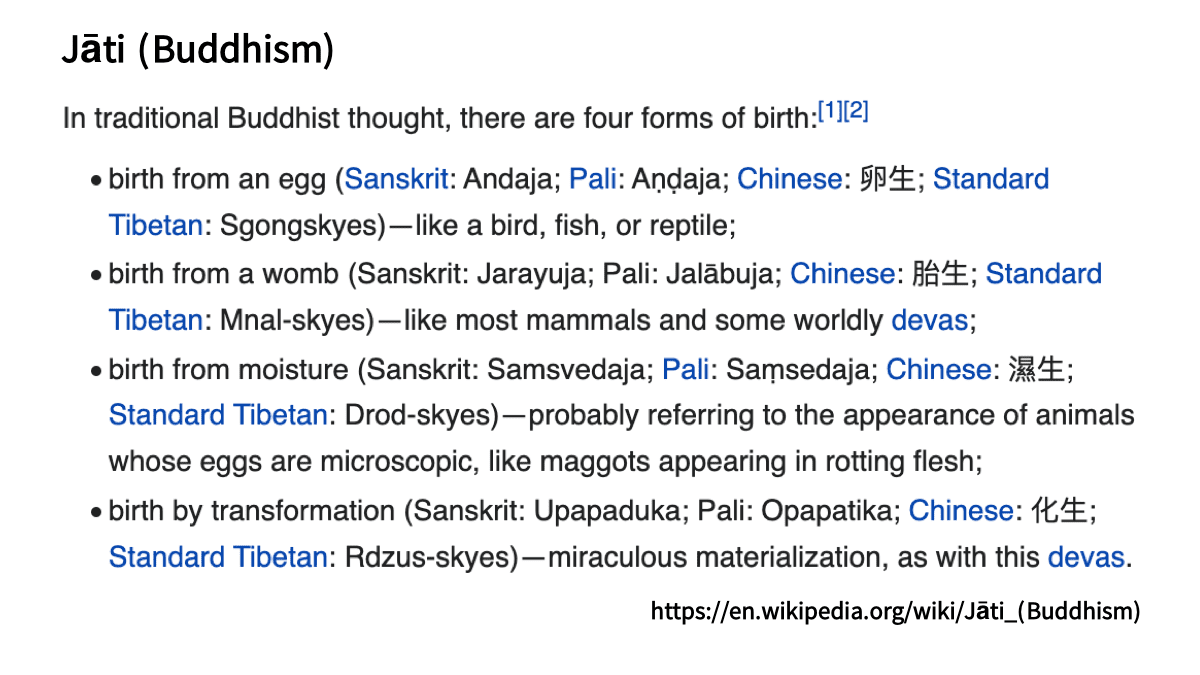Explanation in English [1][2]
Four forms of birth
In traditional Buddhist thought, there are four forms of birth:
- birth from an egg (Sanskrit: Andaja; Pali: Aṇḍaja; Chinese: 卵生; Standard Tibetan: Sgongskyes)—like a bird, fish, or reptile;
- birth from a womb (Sanskrit: Jarayuja; Pali: Jalābuja; Chinese: 胎生; Standard Tibetan: Mnal-skyes)—like most mammals and some worldly devas;
- birth from moisture (Sanskrit: Samsvedaja; Pali: Saṃsedaja; Chinese: 濕生; Standard Tibetan: Drod-skyes)—probably referring to the appearance of animals whose eggs are microscopic, like maggots appearing in rotting flesh;
- birth by transformation (Sanskrit: Upapaduka; Pali: Opapatika; Chinese: 化生; Standard Tibetan: Rdzus-skyes)—miraculous materialization, as with this devas.
Explanation in Chinese [3]
四生
154. 金剛經與其它經典常提到『四生』,不知四生是何意義?
四生(梵語catasro-yonayan),(巴利語catasso-yoniyo)。指三界六道有情產生之四種類別。
據俱舍論卷八所載,即:
一、卵生(梵語andaja-yoni,巴利語亦同),由卵殼出生者稱為卵生。如鴨、孔雀、雞、蛇、魚、鳥類、蟻等。
二、胎生(梵語jarayuja-yoni, 巴利語jalabu-ja),又作腹生。從母胎而出生者,稱為胎生,如人、象、馬、牛、豬、羊、驢等。
三、濕生(梵語samsvedaja-yoni,巴利語samseds-ja),又作因緣生,寒熱和合生。即由糞聚、注道、穢廁、腐肉,叢草等潤濕地之濕氣所產生者,稱為濕生。如飛蛾、蚊蚰、蠓蚋、麻生蟲等。
四、化生(梵語upapaduka-yoni,巴利語opaptika),無所託而忽有,稱為化生。如諸天、地獄、中有之有情,皆由其過去之業力而化生。以上四生,以化生之眾生為最多。
Explanation in Burmese [4]
သန္ဓေလေးမျိုး
ဘဝတခုတွင် အစစွာ ဖြစ်ခြင်းလေးမျိုးသန္ဓေဆိုသည်မှာ ဘဝတခုတွင် အစစွာဖြစ်ခြင်းကိုဆိုသည်။ သန္ဓေသည် သံသေဒဇ၊ ဩပပါတိက၊ အဏ္ဍဇ၊ ဂဗ္ဘသေယျက ဟူ၍လေးမျိုးဖြစ်သည်။ လူတို့သည် အမိပမ်းတွင်း၌ ကိန်းအောင်း နေရသောကြောင့် ဂဗ္ဘသေယျကအကြောင်း အထူး လေ့လာသင့်ပေသည်။ သန္ဓေလေးမျိုးကိုရေးသားရာ၌ ဇလာဗုဇအစားအခေါ်များအသိများသော ဂဗ္ဘသေယျကကိုသုံးစွဲမည်။
သန္ဓေဆိုသည်မှာ တစ်ဘဝနှင့် တစ်ဘဝ ဆက်စပ်ခြင်း၊တစ်နည်း ဘဝတစ်ခုတွင်အစစွာ ဖြစ်ခြင်းကိုဆိုသည်။ တရားကိုယ်မှာသက်ရှိသတ္တဝါ၏ နာမ်တရားနှင့်ရုပ်တရားပင်တည်း။ ယင်းသန္ဓေကို ပဋိသန္ဓေ ဟူ၍ပါဠိဘာသာ၌ ခေါ်ဝေါ်သုံးစွဲကြသေးသည်။ ထိုသန္ဓေသည် (၁)သံသေဒဇ၊ (၂) ဩပပါတိက၊ (၃) အဏ္ဍဇ၊ (၄) ဇလာဗုဇဟူ၍ လေးမျိုးဖြစ်သည်။ ဇလာဗုဇကိုအမိဝမ်းတွင်း၌ ကိန်းအောင်းနေရသောကြောင့် ဂဗ္ဘသေယျကဟုလည်းခေါ်ဆိုသည်။
၁။ အဏ္ဍဇဆိုသည်မှာ ဥ၌ ဖြစ်သောပဋိသန္ဓေကိုဆိုသည်။ (Oviparity)
၂။ ဂဗ္ဘသေယျကဆိုသည်မှာ အမိဝမ်း၌ကိန်းအောင်း၍တည်ရသောပဋိသန္ဓေကိုဆိုသည်။ (Viviparity)
၃။ သံသေဒဇဆိုသည်မှာ – သစ်ပင်၊ ပန်းပင်၊ နွယ်ပင်၊ မစင်၊ ကျင်ကြီး၊ ကျင်ငယ်၊ ရေပုပ်၊ ရေသိုးစသော အညစ်အကြေး၌ဖြစ်သော ပဋိသန္ဓေကိုဆိုသည်။ (Wet Birth)
၄။ ဩပပါတိက ဆိုသည်မှာ ဘုံ၊ ဗိမာန်၊ ဥယျာဉ်၊ ရေကန်စသောဌာနတို့၌ဖြစ်သော ပဋိသန္ဓေကိုဆိုသည်။ (Metamorphosis (Biological)/ Metaplasia)
[Volunteer needed for Eastern Pwo Karen translation for this post]
[ဤအကြောင်းအရာအား အရှေ့ပိုးကရင်ဘာသာစကားသို့ ပြန်ဆိုရန် စေတနာ့ဝန်ထမ်းအလိုရှိသည်။]
Directly extracted from the following references:
- Jāti (Buddhism) – Wikipedia
- Karma and Rebirth in Buddhism (cam.ac.uk)
- 佛學問答第三輯 (bfnn.org)
- သန္ဓေလေးမျိုး – ဝီကီပီးဒီးယား (wikipedia.org)
![]()

